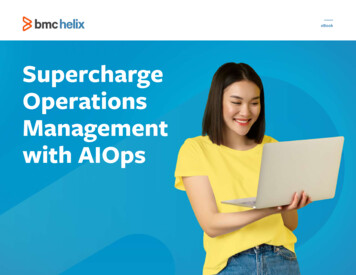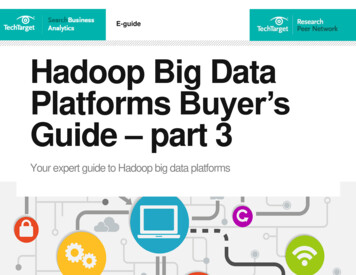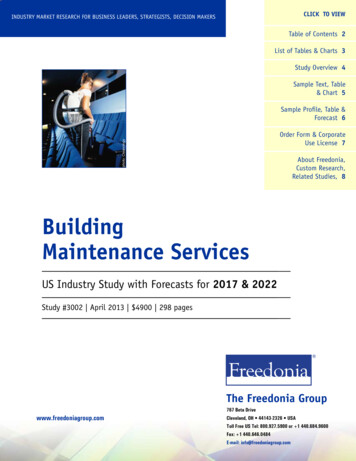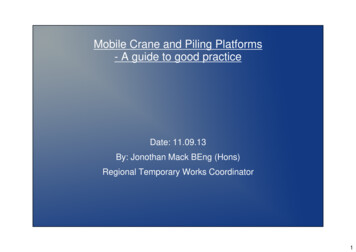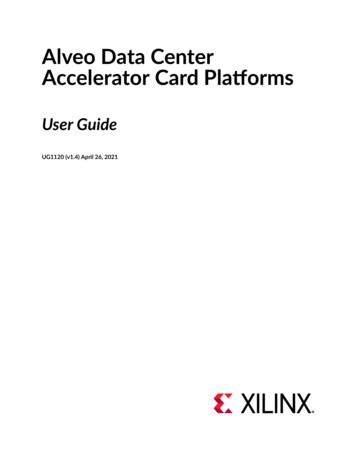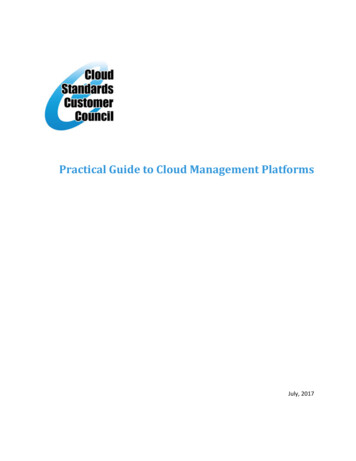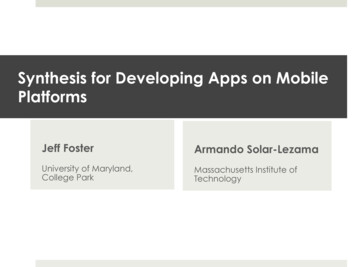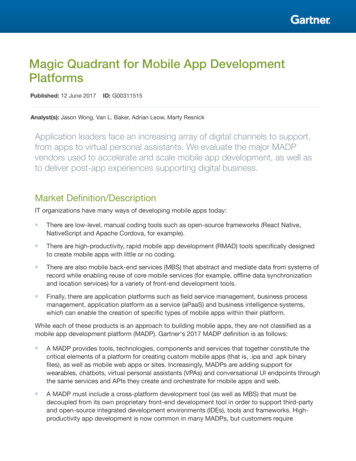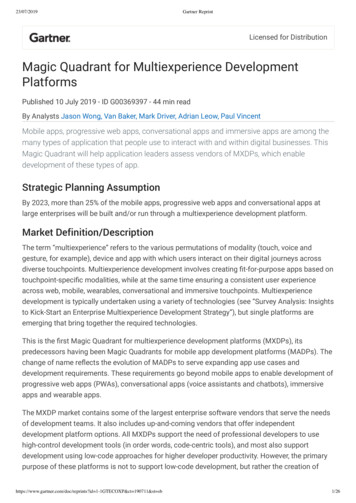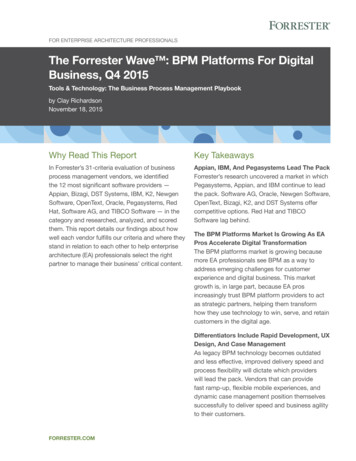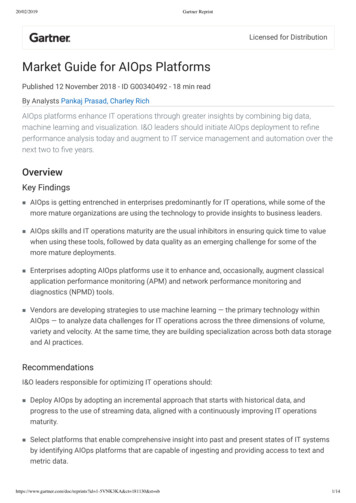
Transcription
20/02/2019Gartner ReprintLicensed for DistributionMarket Guide for AIOps PlatformsPublished 12 November 2018 - ID G00340492 - 18 min readBy Analysts Pankaj Prasad, Charley RichAIOps platforms enhance IT operations through greater insights by combining big data,machine learning and visualization. I&O leaders should initiate AIOps deployment to refineperformance analysis today and augment to IT service management and automation over thenext two to five years.OverviewKey Findings AIOps is getting entrenched in enterprises predominantly for IT operations, while some of themore mature organizations are using the technology to provide insights to business leaders. AIOps skills and IT operations maturity are the usual inhibitors in ensuring quick time to valuewhen using these tools, followed by data quality as an emerging challenge for some of themore mature deployments. Enterprises adopting AIOps platforms use it to enhance and, occasionally, augment classicalapplication performance monitoring (APM) and network performance monitoring anddiagnostics (NPMD) tools. Vendors are developing strategies to use machine learning — the primary technology withinAIOps — to analyze data challenges for IT operations across the three dimensions of volume,variety and velocity. At the same time, they are building specialization across both data storageand AI practices.RecommendationsI&O leaders responsible for optimizing IT operations should: Deploy AIOps by adopting an incremental approach that starts with historical data, andprogress to the use of streaming data, aligned with a continuously improving IT operationsmaturity. Select platforms that enable comprehensive insight into past and present states of IT systemsby identifying AIOps platforms that are capable of ingesting and providing access to text andmetric data.https://www.gartner.com/doc/reprints?id 1-5VNK3KA&ct 181130&st sb1/14
20/02/2019Gartner Reprint Deepen their IT operations team’s analytical skills by selecting tools that support the ability toincrementally deploy the four phases of IT-operations-oriented machine learning: descriptive,diagnostic, proactive capabilities and root cause analysis to help avoid high-severity outages.Market DefinitionAIOps platforms combine big data and machine learning functionality to support all primary IToperations functions through the scalable ingestion and analysis of the ever-increasing volume,variety and velocity of data generated by IT. The platform enables the concurrent use of multipledata sources, data collection methods, and analytical and presentation technologies.Market DescriptionAIOps can enhance a broad range of IT operations processes and tasks, including performanceanalysis, anomaly detection, event correlation and analysis, IT service management andautomation.Their central function is: Ingesting data from multiple sources agnostic to source or vendor Enabling data analytics at two points: Real-time analysis at the point of ingestion Historical analysis of stored data Providing access to the data Storing the acquired data Using machine learning Initiating an action or next step based on the result of analysisThe goal of the analytics effort is the discovery of patterns — novel elements used to look forwardin time to predict possible incidents and emerging usage profiles — and to look backward in timeto determine the root causes of current system behaviors (see Figure 1).Figure 1. AIOps Platform Enabling Continuous Insights Across IT Operations ts?id 1-5VNK3KA&ct 181130&st sb2/14
20/02/2019Gartner ReprintSource: Gartner (November 2018)Market DirectionAI technology has influenced the evolution of ITOM intermittently over the past two decades, andAIOps platforms are only the most recent example of that influence. IT operations is challenged bythe opposing forces of cost reduction on one hand and increasing operations complexity on theother. The complexity can be defined across the three dimensions of volume, variety and velocityas: Rapid growth in data volumes generated by the IT infrastructure and applications (two- to three-fold increase per annum) The increasing variety of data types generated by machines and humans (for example, metrics,logs, wire data and documents [knowledge management]) The increasing velocity at which data is generated as well as the increasing rate of changewithin IT architectures due to the adoption of cloud-native or other ephemeral architecturesA trade-off in any of these dimensions will prove costly given the insights required by a modernbusiness. Existing monitoring tools are stressed when dealing with high volume, variety andvelocity of data. More importantly, monitoring tools do not cut across the multiple data typesrequired for extracting useful insights. For example, the business needs enormous amounts ofdata that cuts across infrastructure and application metrics, customer sentiment data, businesstransaction data, sensor telemetry, and logs from various systems for additional insights.Non-IT groups like line of business owners and teams that sit outside IT operations (such asapplication developers and DevOps) are increasingly showing interest in AIOps technologies tosurface insights across a multitude of datasets (see “Artificial Intelligence for IT Operationshttps://www.gartner.com/doc/reprints?id 1-5VNK3KA&ct 181130&st sb3/14
20/02/2019Gartner ReprintDelivers Improved Business Outcomes”). In some cases, security and IT operations teams areexploring opportunities to leverage a common platform (see “Align NetOps and SecOps ToolObjectives With Shared Use Cases”). The performance and maturity of the AIOps platform towardenabling the multiple use cases across IT and security operations have been primary inhibitorsagainst a common platform deployment.Further, the speed with which IT needs to act is also increasing due to digital business, hence theneed for tools that can help: Reduce noise (for example, in the form of false alarms or redundant events) Provide better causality, which helps identify probable cause of incidents Capture anomalies that go beyond static thresholds to proactively detect abnormal conditions Extrapolate future events to prevent potential breakdowns Initiate action to resolve a problem (either directly or via integration)To date, AIOps functionality has primarily been used in support of IT operations processes thatenable the monitoring or observation of IT infrastructure, application behavior or digitalexperience. AIOps platform investments have almost always been justified on the basis of theirability to decrease mean time to problem resolution. And they have been justified regardless ofwhether this takes the form of using machine learning to deduplicate events in an eventmanagement context or to analyze application log data in conjunction with bytecodeinstrumentation-based or distributed tracing data in an APM context.AIOps platforms are expanding the range of data types they are capable of ingesting. In particular,vendors that supported only the ingestion of log data in the past are now expanding their scope toinclude metric and wire data.Therefore, given both supply- and demand-side trends and technical differences, Gartneranticipates that, over the next five years, wide-scope AIOps platforms will become the de factoform-factor for the delivery of AIOps functionality as opposed to AIOps functionality embedded ina monitoring tool like APM, NPMD or ITIM (see “Deliver Cross-Domain Analysis and Visibility WithAIOps and Digital Experience Monitoring”).Gartner clients have demonstrated increasing interest in using AIOps functionality to improveengagement with incidents and problems by applying big data and machine learning to troubleticketing to analyze the effectiveness of the service desk.1 , 2IT organizations have also started exploring AIOps in a DevOps context as part of the continuousintegration/continuous delivery (CI/CD) cycle to predict potential problems prior to deploymentand to detect potential security issues 3 (see “Market Guide for Continuous ConfigurationAutomation Tools”).https://www.gartner.com/doc/reprints?id 1-5VNK3KA&ct 181130&st sb4/14
20/02/2019Gartner ReprintAIOps analysis is expanding beyond its initial usage as a better solution for event correlation andanalysis in IT operations. I&O leaders are beginning to focus on use cases beyond the realm of IToperations. As an example, since January 2018, Gartner clients have expressed interest indesigning dashboards showing real-time analysis of customer satisfaction, the order process andbusiness health. 4 The goal in this case is to present line of business owners with real-timeinsights into the impact of IT on business, keeping them informed and enabling them to makedecisions based on relevant data.Gartner believes that AIOps will evolve into a bidirectional solution that not only ingests data foranalysis, but also initiates actions based on its analysis. These actions, most likely via integrationto other ITOM and ITSM tools, will take several forms, including: Alerting Problem triage CMDB population Run book automation Application release orchestrationAIOps tools show a “right-shift” across the four stages of monitoring — data acquisition,aggregation, analysis and action (see Figure 2) — with their core capabilities at data aggregationand analysis. As the technology matures further, users will be able to leverage proactive advicefrom the platform, enabling the action stage.With increasing instrumentation in modern applications, data acquisition as a native applicationcapability is leveraged by some organizations. In addition, some users leverage open-sourcetechnologies for the data acquisition function, thereby bypassing APM as a specialized domainmonitoring tool and using AIOps as the primary source for the monitoring function.The debate regarding monitoring tools versus AIOps has just begun, and it will likely grow.Nevertheless, in the long run, monitoring tools will exist for the domain specialist, whereas, for anIT operations generalist, the primary go-to tool will be AIOps.Figure 2. Four Stages of Monitoringhttps://www.gartner.com/doc/reprints?id 1-5VNK3KA&ct 181130&st sb5/14
20/02/2019Gartner ReprintSource: Gartner (November 2018)Market AnalysisTo date, few vendors offer comprehensive, integrated AIOps platforms. Many vendors do, however,offer a wide range of AIOps capabilities, subsets of which are integrated with one another. To geta clearer picture of how the market is evolving and where vendors are positioned with regard toone another, Gartner has divided currently available AIOps capabilities into two major categoriesacross data management and analytical outcomes:Data Ingestion and Handling Historical and streaming data management — Software or appliances that allow for theingestion, indexing and persisted storage of log data, wire data, metrics and document data(see Note 2). The resulting databases are mostly unstructured or polystructured, while thestored datasets accumulate in high volumes, change with high velocity and are implicitlystructured according to highly varied formats. This historical data management functionalitycan be called “big data management.” To provide value under the IT operations use case, thetool must also present data in time scales perceived by a human user as real time, deliveringdata directly at the point of ingestion without requiring access to a persisted database. It mustprovide a coherent analysis across multiple streams of real-time and historical data.Analytical Outcomes Basic and advanced statistical analysis— A combination of univariate and multivariateanalysis, including the use of correlation, clustering, classifying and extrapolation on metricscaptured across IT entities as well as for curating data at source. Automated pattern discovery and prediction — Use of historical or streaming data of one ormore of the types mentioned above, to elicit mathematical or structural patterns that describehttps://www.gartner.com/doc/reprints?id 1-5VNK3KA&ct 181130&st sb6/14
20/02/2019Gartner Reprintnovel correlations that may be inferred from, but are not immediately present in, the datasetsthemselves. These patterns may then be used to go forward in time and predict incidents withvarying degrees of probability. Anomaly detection — Using the patterns discovered by the previous components to firstdetermine what constitutes normal system behavior, and then to discern departures from thatnormal system behavior. Root cause determination — Pruning down the network of correlations established by theautomated pattern discovery and prediction component to isolate those links of dependencythat represent genuine causal relationships in the sense of providing recipes for effectiveintervention. Prescriptive advice — Performing triage on problems, classifying them into known categories. Itmay then mine stores of prior solutions, analyzing these for applicability and offering them in aprioritized form for usage of remediation. Eventually, these will use a closed-loop approach andenable voting on their effectiveness after they are utilized. Topology— For the patterns AIOps detects to be relevant and actionable, a context must beplaced around the data ingested. That context is topology. Without the context and de factoconstraint of topology, the patterns detected, while valid, may be unhelpful and distracting.Deriving patterns from data within a topology will reduce the number of patterns, establishrelevancy and illustrate hidden dependencies. Using topology as part of causality determinationcan greatly increase its accuracy and effectiveness. Capturing where events occurred and theirup and downstream dependencies using graph and bottleneck analysis can provide greatinsight on where to focus remediation efforts.There is some confusion in the market concerning whether AIOps will replace domain-centricmonitoring tools such as APM, NPMD, ITIM and DEM (see “Hype Cycle for IT PerformanceAnalysis, 2018”). AIOps will not replace monitoring tools, rather it will provide enhanced analyticsand more actionable data. Domain-centric monitoring tools will continue to exist providing datacapture, analysis and visualization of their domains for the specialist. However, they will forwardtheir data streams to an AIOps platform, acting as a lens where the data will be focused into asingle, coherent cross-domain analysis (see “Deliver Cross-Domain Analysis and Visibility WithAIOps and Digital Experience Monitoring”).As the market evolves, Gartner has observed evolving AIOps capabilities across variousdimensions: Vendors going to market with a data-source-agnostic AIOps platform. These products tend tobe generic and cater to the broadest use cases. Vendors that have the key components, but tend to have a restricted set of data sources. Thesevendors are typically focused on one domain (for example, network, endpoint systems andhttps://www.gartner.com/doc/reprints?id 1-5VNK3KA&ct 181130&st sb7/14
20/02/2019Gartner ReprintAPM), or are selective about data types like alert streams from other tools. Such tools tend tohave a restricted set of use cases, targeted at a certain segment of IT operations. Some vendors with existing monitoring solutions limit data sources to their own monitoringproducts or extend to a limited partner ecosystem. This is again a case where the targetaudience is limited to those with the right mix of data sources. Some open-source projects enable users to assemble their own AIOps platforms by offeringtools for data ingest, a big data platform, ML and a visualization layer. End users can mix andmatch the components from multiple providers.AIOps platforms add important capabilities beyond what a monitoring tool with embedded AIOpscan provide. The AIOps platforms free from the implied lock-in to a static data model expressed inmonitoring tools is able to capture the patterns, anomalies and causal structures in the data itself.Monitoring tools may miss these features in the data as they force it into their predeterminedmodels.Representative VendorsThe vendors listed in this Market Guide do not imply an exhaustive list. This section is intended toprovide more understanding of the market and its offerings.Market IntroductionAIOps platform vendors have a broad range of capabilities that continues to grow. Vendors differin their data-ingest and out-of-the-box use cases made available with minimal configuration.In Table 1, we have provided a representative, sample list of vendors providing AIOps platformfunctionality.Table 1: Representative d Stateshttps://www.bigpanda.ioBMC1980United eshttps://www.gartner.com/doc/reprints?id 1-5VNK3KA&ct 181130&st sbUnited Stateshttps://www.ca.com/us.html8/14
20/02/2019VendorsGartner ReprintYearHeadquartersWebsite2011United Stateshttps://www.devo.com/Elastic2012United Stateshttps://www.elastic.co/Evolven2007United /FixStream2013United Stateshttps://fixstream.com/IBM1911United Stateswww.ibm.comInfluxData2013United Stateshttps://www.influxdata.com/ITRS1993United Kingdomhttps://www.itrsgroup.com/jKool2014United Stateshttps://www.jkoolcloud.com/Loom2015United 011United Stateshttps://www.moogsoft.com/Scalyr2012United d Stateshttps://sciencelogic.com/SignalFx2013United Stateshttps://signalfx.com/Splunk2004United andshttps://www.stackstate.com/Sumo Logic2010United Stateshttps://www.sumologic.com/VNT artner.com/doc/reprints?id 1-5VNK3KA&ct 181130&st sb9/14
20/02/2019Gartner ReprintSource: Gartner (November 2018)Market RecommendationsEnsure Success in the Deployment of AIOps Functionality by Adopting anIncremental ApproachThe effective deployment of AIOps functionality requires a structured approach starting with thereorganization of IT domains according to data sources. This approach shifts the required focustoward datasets as opposed to tools, which has been the traditional approach. Gartner has foundthat it is best to begin with mastering the use of large persistent datasets ingested from a varietyof sources. Only after the IT operations team has become fluent with the big data aspect of AIOpsshould it attempt mastery of the capability categories (see “12 Steps to Artificial Intelligence for ITOperations Excellence”). Hence, when selecting tools or services, an enterprise should prioritizethose vendors that allow for the deployment of data ingestion, storage and access, independentfrom the remaining AIOps components. Given that AIOps will be used for multiple use cases, I&Oleaders must ensure that the vendors support the gradual addition of those other functionalities.Select AIOps Platforms Capable of Supporting a Broad Range of Historical andStreaming Data TypesModern IT operations aim to gain a composite visibility to IT entities, including applications, theirrelationships, interdependencies and past transformations to gain insight to the present state ofthe overall IT landscape. Selection of the right data source is crucial in avoiding blind spots. Theprogressive nature of deployment maturity and evolving use cases requires a readiness to ingest avariety of data sources. I&O leaders must select AIOps platforms that are capable of ingesting andproviding access to a broad range of historical and streaming data types (see Figure 3).Figure 3. Data Types for Ingestion in AIOpshttps://www.gartner.com/doc/reprints?id 1-5VNK3KA&ct 181130&st sb10/14
20/02/2019Gar
diagnostics (NPMD) t ools. Vendors are developing strategies to use machine learning — the primar y technology within AIOps — to analyze data challenges for I T operations across the three dimensions of v olume, variety and v elocity. At the same time, the y are building specialization acr oss both data st orage and AI practices.
